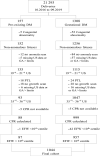Ultrasound predictors of adverse outcome in pregnancy complicated by pre-existing and gestational diabetes
- PMID: 35441701
- PMCID: PMC9564421
- DOI: 10.1111/aogs.14361
Ultrasound predictors of adverse outcome in pregnancy complicated by pre-existing and gestational diabetes
Abstract
Introduction: Ultrasound assessment of fetuses subjected to hyperglycemia is recommended but, apart from increased size, little is known about its interpretation, and the identification of which large fetuses of diabetic pregnancy are at risk is unclear. Newer markers of adverse outcomes, abdominal circumference growth velocity and cerebro-placental ratio, help to predict risk in non-diabetic pregnancy. Our study aims to assess their role in pregnancies complicated by diabetes.
Material and methods: This is a retrospective analysis of a cohort of singleton, non-anomalous fetuses of women with pre-existing or gestational diabetes mellitus, and estimated fetal weight at the 10th centile or above. Gestational diabetes was diagnosed by selective screening of at risk groups. A universal ultrasound scan was offered at 20 and 36 weeks of gestation. Estimated fetal weight, abdominal circumference growth velocity, presence of polyhydramnios, and cerebro-placental ratio were evaluated at the 36-week scan. A composite adverse outcome was defined as the presence of one or more of perinatal death, arterial cord pH less than 7.1, admission to Neonatal Unit, 5-minute Apgar less than 7, severe hypoglycemia, or cesarean section for fetal compromise. A chi-squared test was used to test the association of estimated fetal weight at the 90th centile or above, polyhydramnios, abdominal circumference growth velocity at the 90th centile or above, and cerebro-placental ratio at the 5th centile or below with the composite outcome. Logistic regression was used to assess which ultrasound markers were independent risk factors. Odds ratios of composite adverse outcome with combinations of independent ultrasound markers were calculated.
Results: A total of 1044 pregnancies were included, comprising 87 women with pre-existing diabetes mellitus and 957 with gestational diabetes. Estimated fetal weight at the 90th centile or above, abdominal circumference growth velocity at the 90th centile or above, cerebro-placental ratio at the 5th centile or below, but not polyhydramnios, were significantly associated with adverse outcomes: odds ratios (95% confidence intervals) 1.85 (1.21-2.84), 1.54 (1.02-2.31), 1.92 (1.21-3.30), and 1.53 (0.79-2.99), respectively. Only estimated fetal weight at the 90th centile or above and cerebro-placental ratio at the 5th centile or below were independent risk factors. The greatest risk (odds ratio 6.85, 95% confidence interval 2.06-22.78) was found where both the estimated fetal weight is at the 90th centile or above and the cerebro-placental ratio is at the 5th centile or below.
Conclusions: In diabetic pregnancies, a low cerebro-placental ratio, particularly in a macrosomic fetus, confers additional risk.
Keywords: cerebro-placental ratio; diabetes in pregnancy; estimated fetal weight; fetal Doppler; fetal growth.
© 2022 The Authors. Acta Obstetricia et Gynecologica Scandinavica published by John Wiley & Sons Ltd on behalf of Nordic Federation of Societies of Obstetrics and Gynecology (NFOG).
Conflict of interest statement
None.
Figures
Similar articles
-
The fetal cerebro-placental ratio in diabetic pregnancies is influenced more by the umbilical artery rather than middle cerebral artery pulsatility index.Eur J Obstet Gynecol Reprod Biol. 2017 Apr;211:56-61. doi: 10.1016/j.ejogrb.2017.02.001. Epub 2017 Feb 3. Eur J Obstet Gynecol Reprod Biol. 2017. PMID: 28189724
-
Is the fetal cerebroplacental ratio better that the estimated fetal weight in predicting adverse perinatal outcomes in a low risk cohort?J Matern Fetal Neonatal Med. 2019 Jul;32(14):2380-2386. doi: 10.1080/14767058.2018.1438394. Epub 2018 Feb 18. J Matern Fetal Neonatal Med. 2019. PMID: 29455616
-
Reduced growth velocity from the mid-trimester is associated with placental insufficiency in fetuses born at a normal birthweight.BMC Med. 2020 Dec 24;18(1):395. doi: 10.1186/s12916-020-01869-3. BMC Med. 2020. PMID: 33357243 Free PMC article.
-
Role of Cerebroplacental Ratio in Predicting the Outcome of Pregnancies Complicated by Diabetes.Fetal Diagn Ther. 2024;51(1):55-65. doi: 10.1159/000534483. Epub 2023 Nov 3. Fetal Diagn Ther. 2024. PMID: 37926070
-
Diagnostic performance of third-trimester ultrasound for the prediction of late-onset fetal growth restriction: a systematic review and meta-analysis.Am J Obstet Gynecol. 2019 May;220(5):449-459.e19. doi: 10.1016/j.ajog.2018.09.043. Epub 2019 Jan 8. Am J Obstet Gynecol. 2019. PMID: 30633918
Cited by
-
Fetomaternal Doppler sonography for the prediction of perinatal outcome in term pregnancies complicated by gestational diabetes mellitus: does it have potential?Ultrasound Int Open. 2025 Apr 29;11:a25540806. doi: 10.1055/a-2554-0806. eCollection 2025. Ultrasound Int Open. 2025. PMID: 40309347 Free PMC article.
-
Prognostic Accuracy of Antenatal Doppler Ultrasound Measures in Predicting Adverse Perinatal Outcomes for Pregnancies Complicated by Diabetes: A Systematic Review.AJOG Glob Rep. 2023 Jun 10;3(3):100241. doi: 10.1016/j.xagr.2023.100241. eCollection 2023 Aug. AJOG Glob Rep. 2023. PMID: 37396341 Free PMC article. Review.
-
Fetal biometry measurements in diabetic pregnant women and neonatal outcomes.Obstet Gynecol Sci. 2025 Jan;68(1):69-78. doi: 10.5468/ogs.24230. Epub 2024 Nov 29. Obstet Gynecol Sci. 2025. PMID: 39609373 Free PMC article.
-
Sonographic Predictors of Adverse Perinatal Outcomes in Pregnancies Complicated by Hyperglycaemia.J Obstet Gynaecol India. 2025 Apr;75(Suppl 1):466-472. doi: 10.1007/s13224-024-02084-3. Epub 2024 Nov 26. J Obstet Gynaecol India. 2025. PMID: 40390923
-
Neonatal outcomes and rationale for timing of birth in perinatal diabetes: a retrospective cohort study.Am J Obstet Gynecol MFM. 2023 Oct;5(10):101129. doi: 10.1016/j.ajogmf.2023.101129. Epub 2023 Aug 9. Am J Obstet Gynecol MFM. 2023. PMID: 37567447 Free PMC article.
References
-
- American College of Obstetricians and Gynecologists . ACOG practice bulletin no. 201: pregestational diabetes mellitus. Obstet Gynecol. 2018;132:e228‐e248. - PubMed
-
- Voormolen DN, DeVries JH, Sanson RM, et al. Continuous glucose monitoring during diabetic pregnancy (GlucoMOMS): a multicentre randomized controlled trial. Diabetes Obes Metab. 2018;20:1894‐1902. - PubMed
-
- Esakoff TF, Cheng YW, Sparks TN, Caughey AB. The association between birthweight 4000 g or greater and perinatal outcomes in patients with and without gestational diabetes mellitus. Am J Obstet Gynecol. 2009;200:672‐e1. - PubMed
-
- Sovio U, Moraitis AA, Wong HS, Smith GC. Universal vs selective ultrasonography to screen for large‐for‐gestational‐age infants and associated morbidity. Ultrasound Obstet Gynecol. 2018;51:783‐791. - PubMed
MeSH terms
LinkOut - more resources
Full Text Sources
Medical


